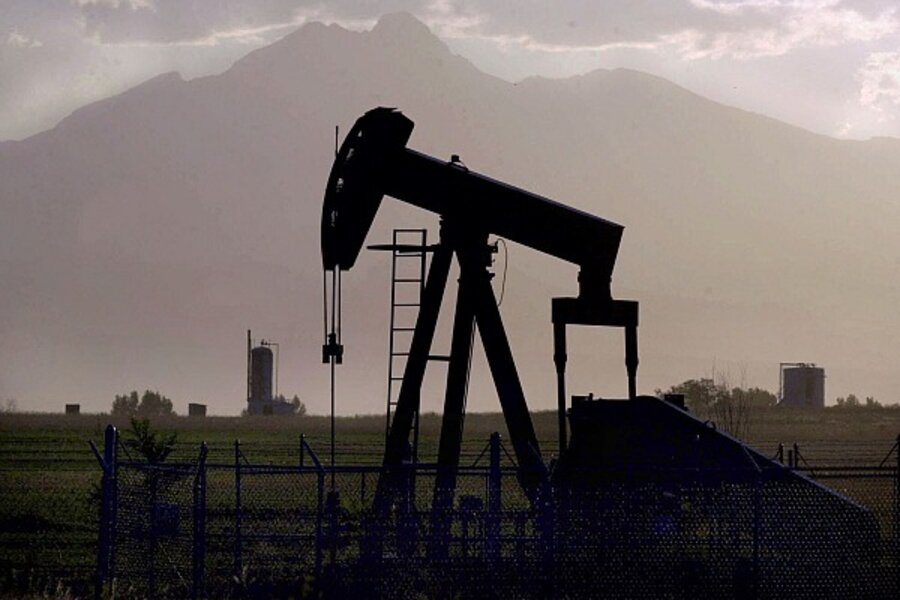International Energy Agency says 'peak oil' has hit. Crisis averted?
Loading...
It was a looming doomsday scenario: "Peak oil" would someday hit, potentially sending food prices soaring, stock markets reeling, and countries to war to seize and protect remaining oil reserves.
Instead, the International Energy Agency said Tuesday, peak crude oil already came and went unnoticed in 2006.
Crisis averted, apparently.
Still, says IEA Chief Economist Fatih Birol, you can well expect the price oil and gas to continue rising.
ALTERNATIVE ENERGY QUIZ: Are you "smarter than Al Gore"?
“The age of cheap oil is over,” Dr. Birol said in a telephone interview from Brussels. “Governments and consumers should be prepared to pay higher oil prices.”
$200 per barrel of oil?
According to the IEA's World Energy Outlook, released Nov. 9, oil demand will increase to 99 million barrels per day (mbd) by 2035, up from 84 mbd in 2009. This will drive oil prices over $200 a barrel by 2035, which is equivalent to $113 in 2009 real dollars.
That scenario assumes governments will implement broad policy commitments and plans that they have already announced to reduce carbon emissions. But if governments continue at their current pace of oil use, then by 2035 the price of crude oil will near $240 per barrel ($135 in real dollars) as demand rises to 107 mbd, according to the report.
The IEA said less developed nations will account for 93 percent of the projected increase in world energy demand. China, in particular, is projected to account for 39 percent of rising energy demand and 57 percent of rising global oil demand.
Peak oil passed, probably
Global crude oil production, though, has already peaked, according to the IEA. The difference between supply and demand will be made up from rising production of natural gas liquids and unconventional oil, notably Canadian oil sands. Crude oil output will plateau at about 69 mbd by 2015, according to the IEA, marginally below the all-time peak of 70 mbd reached in 2006. Total oil production, which includes the oil sands and liquid gas, will not peak before 2035.
It should be noted that, according to the IEA's projections, crude oil production has only peaked if we assume that governments will implement their new policies to curb carbon emissions and spur renewable energy sources. Otherwise, crude oil production will continue to rise to 74 mbd by 2035.
On the other end, if governments can adopt more stringent policies to curb climate change and prevent a sharp rise in global warming, then the world could see a significant drop in oil production to below 60 mbd over the next two decades.
“If governments act vigorously now to encourage more efficient use of oil and the development of alternatives, then demand for oil might begin to ease quite soon and we might see a fairly early peak in oil production,” according to the IEA report.
Future crude oil producers
Saudi Arabia will soon retake its place as the world's top oil producer as recovery falls in Russia, according to the IEA. From 9.6 mbd in 2009, Saudi Arabian oil production is projected to skyrocket 52 percent to 14.6 million barrels a day by 2035. Russian oil production will remain steady to 2015 and then fall off, to 9.1 mbd in 2035 (down from 10.2 mbd in 2009).
Here’s a look at some the IEA's other projections on oil production in the coming decades:
- Iraq: Oil production will double to 5.3 million a day by 2025, surpassing Iranian output levels around 2015. It will continue to 7 mbd by 2035.
- Iran: Slow increase, from 4.3 mbd in 2009 to 5.3 mbd in 2035.
- Kuwait: Rise from 2.5 mbd in 2009 to 3.6 mbd in 2035.
- Brazil: Production will grow from 2 mbd in 2009 to 5.2 mbd in 2035, driven mainly by the pre-salt layers found offshore, including the Tupi and Jupiter fields.
- Venezuela: Oil production will rise from 2.4 mbd in 2009 to 4 mbd in 2035.
- Canada: Oil production will rise from 3.2 mbd in 2009 to 5.3 mbd in 2035, primarily from increased production in the oil sands of Alberta and on the eastern seaboard and Arctic regions.
- United States: Oil production will fall steadily from 7.4 mbd in 2009 to 7.1 mbd in 2035. Increased production offshore in the Gulf of Mexico, which has helped offset decline in older producing areas, is in question because of the Macondo disaster.
- Mexico: Oil production will drop from 3 mbd in 2009 to 2.5 mbd in 2035. Production of new oil fields will not be able to keep pace with the decline of the Cantarell super-giant field.
- Europe: Production, mainly in the North Sea, will continue a steady decline from 4.5 mbd in 2009 to 2.1 mbd in 2035.
- China: Production will hold steady at about 3.8 mbd to 2015, and then fall to 2.4 mbd by 2035.
- Africa: Deepwater production off the coast of West Africa, along with production in Uganda, Nigeria, and Ghana will potentially provide new sources of oil, though political conflict could impede development. Overall production is projected to drop from 2.5 mbd in 2009 to 1.8 mbd in 2035 as existing reserves fall off.





